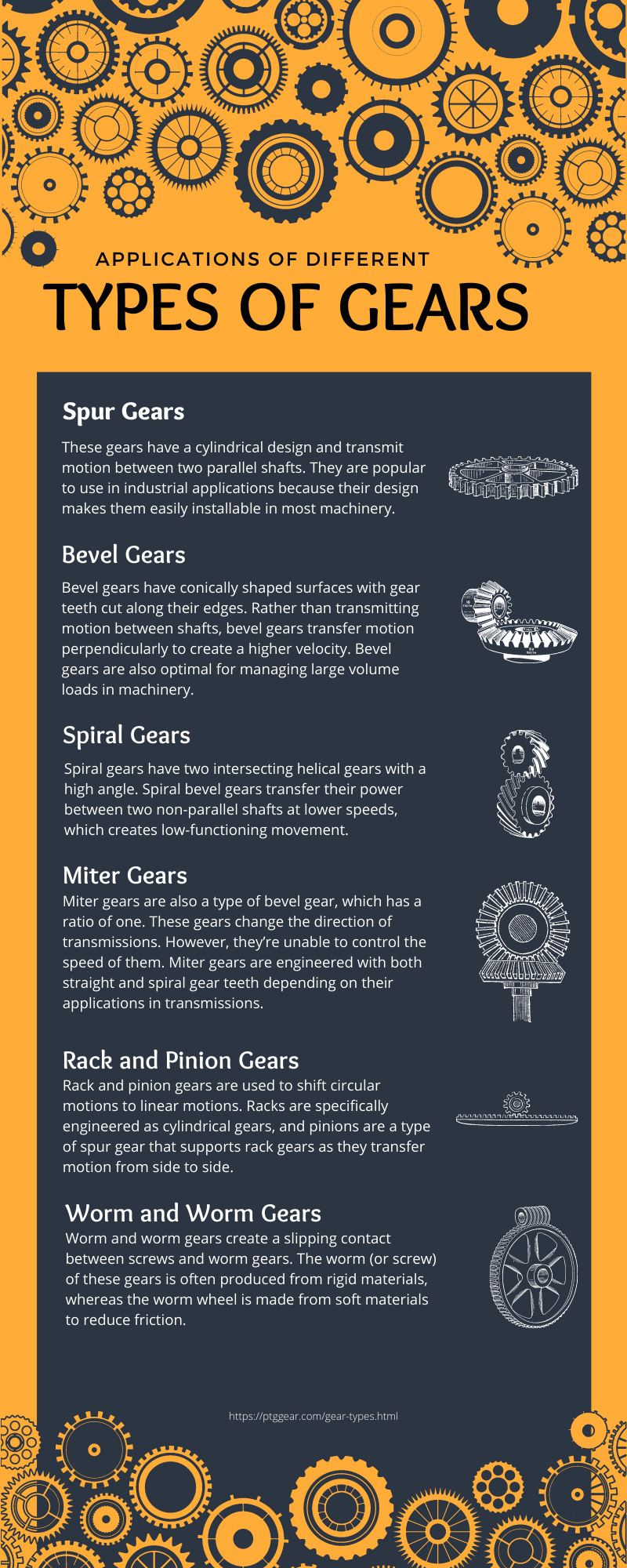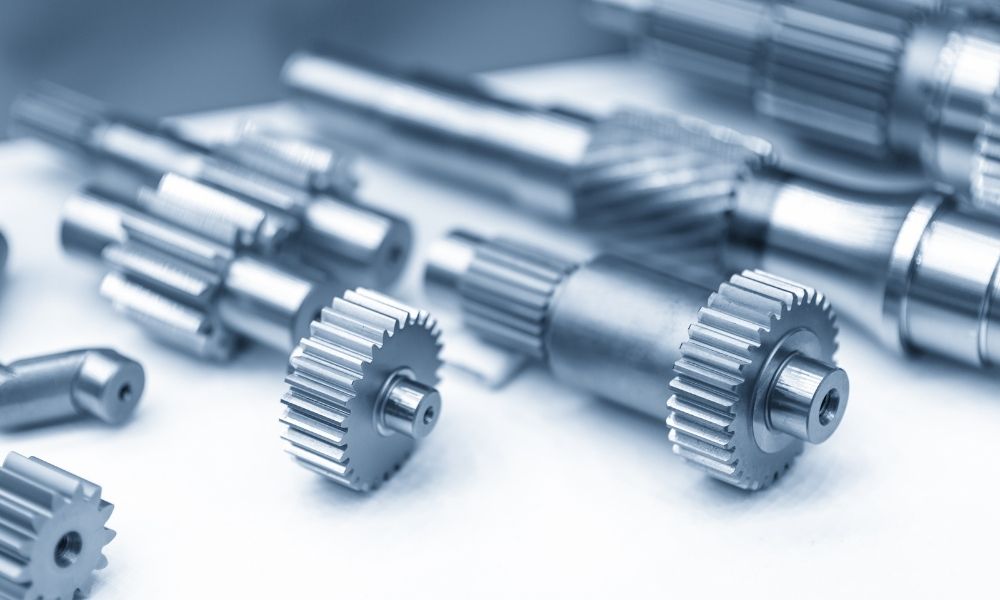When repairing your facility's equipment, it’s vital to understand what gears need repair and how they affect your machinery. Although learning about the different types of gears and their purposes may seem overcomplicated or unimportant, it’s essential to understand them in order to have successful repairs.
There are many types of gears used in machinery. Each of these gears is engineered to transfer motion from one shaft to another. However, the uses of these gears in various industrial, automotive, and commercial applications all vary depending on their design. To learn more about the designs of these mechanisms and the application of different types of gears, continue reading our guide.
Spur Gears
One of the most common types of gears is spur gears. These gears have a cylindrical design and transmit motion between two parallel shafts. They are popular to use in industrial applications because their design makes them easily installable in most machinery. Spur gears can fit even in the tightest of equipment gearboxes and transmissions.
Since their design is highly effective, this gear is also commonly custom-manufactured to improve overall machine efficiency. Spur gears are also less likely to dislodge in equipment, making them a highly durable gear option. The versatility of these gears makes them useful for a variety of machine applications.
Applications of Spur Gears
- Transmissions
- Conveyor belts
- Gear pumps
- Bicycles
- Washing machines
Helical Gears
Helical gears have slanted teeth along their gear axis. The teeth of helical gears are longer than most spur gears, making them more effective at transferring higher power between shafts. Helical gears are also known to reduce vibration and noise when they operate in equipment. The designs of these gears make them optional for working in transmissions and other industrial equipment.
Applications of Helical Gears
- Automatic transmissions
- Conveyor belts
- Factory systems
Bevel Gears
There are many different types of bevel gears, including straight bevel gears, spiral bevel gears, hypoid gears, and miter gears. Although all these designs aren’t engineered the same, they have similar uses.
Bevel gears have conically shaped surfaces with gear teeth cut along their edges. Rather than transmitting motion between shafts, bevel gears transfer motion perpendicularly to create a higher velocity. Bevel gears are also optimal for managing large volume loads in machinery. There are a variety of different applications for bevel gears.
Applications of Bevel Gears
- Milling machines and tools
- Gardening equipment
- Right angle drives
- Positioning equipment
Spiral Gears
Spiral gears have two intersecting helical gears with a high angle. Spiral bevel gears transfer their power between two non-parallel shafts at lower speeds, which creates low-functioning movement. Due to spiral gears' low power and speed, they're rarely found in industrial equipment and are instead used for more commercial purposes.
Applications of Spiral Gears
- Sewing Machines
- Instruments
- Low-speed equipment
Hypoid Gears
Hypoid gears are another type of spiral bevel gear. However, unlike the design of spiral bevel gears, hypoid gears don’t have two intersecting axes. Instead, their shape is based on a hyperboloid, which is a quadric surface that’s neither a cone nor a cylinder but has a center of symmetry, which creates a hyperbola-like shape. These gears are used in most gearbox applications.
Applications of Hypoid Gears
- Automotive transmissions
Miter Gears
Miter gears are also a type of bevel gear, which has a ratio of one. These gears change the direction of transmissions. However, they’re unable to control the speed of them. Miter gears are engineered with both straight and spiral gear teeth depending on their applications in transmissions. However, these gears are most commonly found in automatic transmissions and gearbox equipment.
Applications of Miter Gears
- Automatic transmissions
- Hand drills
- Garage door openers
Rack and Pinion Gears
Rack and pinion gears are used to shift circular motions to linear motions. Racks are specifically engineered as cylindrical gears, and pinions are a type of spur gear that supports rack gears as they transfer motion from side to side. These gears are used in a wide variety of industrial, automotive, and commercial machines.
Applications of Rack and Pinion Gears
- Car Steering
- Machine wheel rotations
- Lifting Equipment
- Elevators
- Railways
- Garage door openers
Worm and Worm Gears
Worm and worm gears create a slipping contact between screws and worm gears. The worm (or screw) of these gears is often produced from rigid materials, whereas the worm wheel is made from soft materials to reduce friction. Worm and wheel gears are primarily used in skew shafts and positioned at right angles, making them ideal for lifting applications.
Applications of Worm and Worm Gears
- Elevators and lifting machinery
- Off-road automobiles
- Conveyor belt systems
Internal Gears
The teeth of internal gears are located inside the cylinder of the gear rather than the outside. A spiral gear or external gears are situated inside the circumferences of internal gears and rotates around in a circular motion to create a planetary drive. The planetary drive is essential to most electric vehicles and is one of the oldest gear engineering designs. There are several applications for internal gears that create planetary drives.
Applications of Internal Gears
- Tractors
- Construction equipment
- Electrical Vehicles
- Automatic transmissions
Each of these gears is precisely engineered for their industrial, automotive, and commercial applications. Although the design of each of these gears may seem complex, they exist in everyday machinery, equipment, and utensils.
Review these different applications of different gear types to learn more about the particular gears in your machinery and how they operate in your appliances. When you can identify the designs and uses of these gears, you will be more prepared to provide your equipment with the most precise and effective repairs.
Here at Hy-Tech’s Power Transmission Group, we offer the best expertise in gear repairs and manufacturing. We produce custom-made gears for multiple applications in different industries.
Whether your equipment requires custom-manufactured bevel gears for lifting machinery or your miter gears need repair to improve vehicle steering, our team of experts can help. We even reverse-engineer custom gears for customers who require updated gear parts for their business's machinery.
To learn more about our gearbox repair services and manufacturing, browse our website to read more about how our team of experts can assist you with your equipment needs.

